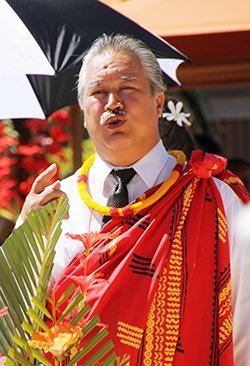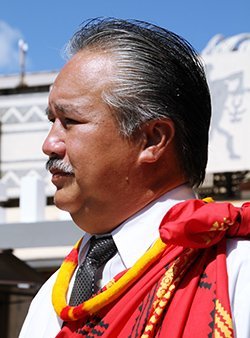Meet Nā’auao: Hawaiian language teacher, composer, chanter
“I’ve always been interested in the Hawaiian language. I heard it growing up and knew vocabulary, but I didn’t really speak it. My grandfather, my dad’s dad, was a native speaker, but he passed away when I was a baby,” said Terry Nā’auao Pane’e, PCC assistant Hawaiian Village manager.

Terry Nā’auao Pane’e, teacher, chanter and composer
But that was years ago. After graduating from Kamehameha School in 1980, Pane’e attended BYU–Hawaii, began working at the Polynesian Cultural Center and also began his serious studies of the Hawaiian language: He took classes at BYUH from Kamoa’e Walk, who also worked with him in the Hawaiian Village, “so I had help outside of class, too, and there were still a few people around who were native speakers. Kamoa’e would take me with him sometimes to talk story with them.”
After graduating from BYUH in 1988, Pane’e attended the University of Hawaii for further Hawaiian language studies; and starting in 1990, he has taught Hawaiian language and studies classes at BYUH as an adjunct faculty member. He has also been a language judge at the Kamehameha Hula Competition for 10 years — “the only one that includes an individual oli [chanting] competition, and He has helped judge high school competitions for several years.
In addition, Pane’e composed the chant and one of the songs used in the Hawaiian portion of the PCC’s canoe pageant; and he composed the chant sung by the Koolauloa Children’s Choir that’s featured in the PCC’s Hawaiian Journey production in the Hawaiian Journey Theater.
“Hawaiian chanting was used to set the tone and mood for a particular occasion,”
Pane’e said, explaining there are “a lot of different types and styles of Hawaiian chanting: There are some that are long and flowing. The kepakepa style is really fast, just like firing, and powerful: Miss Aloha Hula this past year, her oli was done in the kepakepa style. There are some that are more like a dirge or lamentation, that are often done at funerals and wakes. The olioli style is more of a happy or sing-song style; and others.”
“There are chants for different occasions. For example, there are welcoming chants and protocol chants that ask permission to enter an area. There are chants to answer that request. You will sometimes hear genealogy chants at a funeral or at the birth of a child.”
Pane’e continued, listing canoe chants “and navigational chants that help you get to where you want to go. And, of course, [PCC retiree] Cy Bridges wrote Hiki Mai for the BYUH Hawaiian Studies program that ties into our area.”
He explained there are many chants that have been recorded over the years, and that many hula and other groups have their own individual chants. Some chants are associated with certain places.
“Protocol-wise, it always depends on where you are, who you are, who you’re addressing. We tend to identify places and things we know about it.” For example, Pane’e has been asked several times to chant at welcoming powhiri ceremonies in the Maori Village: “Because the marae [village center] is here in Hawaii, Maori protocol dictates that the language of the land should be the first one heard. When that happens, I have to find out who’s coming and why, so I can weave that into my welcoming chant.”
 Though he’s skilled, Panee doesn’t necessarily see himself as a chanter. Still, he finds he’s sometimes asked on a moment’s notice to share chants. “Luckily, I have a chant or two that I can pull up; and because they’re ones that I wrote, it’s very unlikely anyone else will use them.”
Though he’s skilled, Panee doesn’t necessarily see himself as a chanter. Still, he finds he’s sometimes asked on a moment’s notice to share chants. “Luckily, I have a chant or two that I can pull up; and because they’re ones that I wrote, it’s very unlikely anyone else will use them.”
Asked how young Hawaiians learn to chant, Pane’e repled, “Most often a student gets with a kumu to learn to chant. There are also chant and dance classes at some of the universities. We don’t have any yet at BYU–Hawaii, but I believe there’s room for one.”
“Often times hula competitions will have a theme, and chants have to fall within that theme, or there will be a competition chant,” he added. “All that is given to the group kumu are the words, so the style and presentation is left up to them. There can be totally different styles with the same chant. The words are the same, but how they express them can be totally different.”
Pane’e said he he’s judging chants, “I’m listening for enunciation, phrasing — or pausing in the right places, style and flow. I also still compose songs, but they come when they come. For instance, Aunty Sunday Mariteragi did a song this year that I wrote a year ago. That song just popped into my head back then as I was driving to Kaneohe: I had to pull over by Kualoa and rework it, to make sure I remembered everything. That was out of the blue; I wasn’t thinking about it.”
Today, Pane’e is happy about the resurgence of Hawaiian language. “It’s a lot stronger. It’s good to help perpetuate it for the next generation, so we don’t let it slide, like we did in the past. It’s important that we learn from our past generations; but I think it’s also important for us in this and future generations to compose new things. The styles that our kūpuna [elders/ancestors] used in the past are different than the ones we’re using now, sometimes simply because of the circumstances. We don’t live in the same times and situations.”
“It’s important for us to listen to the traditional things of our kūpuna so that we understand their mana’o [thoughts and intentions], so we can perpetuate them; but if we don’t write anything new in this day and age, our mo’opuna [grandchildren] won’t have anything to know who we are. Things are different now. Life is different. We need to perpetuate that, also, so that they may know what life was like when we were here.”
Story and images by Mike Foley

Mike Foley, who has worked off-and-on
at the Polynesian Cultural Center since
1968, has been a full-time freelance
writer and digital media specialist since
2002, and had a long career in marketing
communications and PR before that. He
learned to speak fluent Samoan as a
Mormon missionary before moving to Laie
in 1967 — still does, and he has traveled
extensively over the years throughout
Polynesia and other Pacific islands. Foley
is mostly retired now, but continues to
contribute to various PCC and other media.

Recent Comments